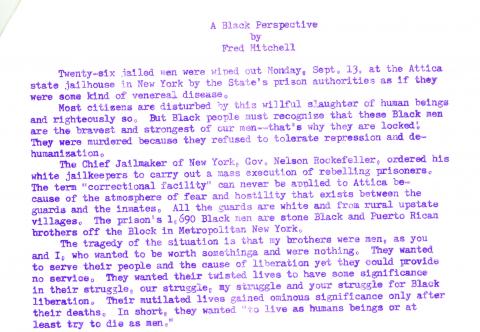The Congress of African Students (CAS) circulated it's first issue of their group's publication, "NIA-PURPOSE."
Nate Caleb, the group's Minister of Communications and Correspondence began the first issue with a section entitled "Black Ideology." In this section, Caleb affirmed CAS' adherence to the Afrocentric theories put forth by Maulana Karenga and Asante (two eminent Africana/Black Studies theorists). Caleb explicitly endorses Karenga's Kawaida theory, drawing strongly on Karenga's idea that the creation of a strong, national culture is an effective strategy for resisting oppression. Caleb also outlines the "seven-fold path to blackness: to think, talk, act, create, buy, vote, and live black." He ends the introductory section of the publication with the seven principles of Nguzo Saba (again, drawing from Kawaida theory.) It is here that the purpose of the title of the publication becomes evident: "Nia (purpose): To make as our collective vocation the building and developing of our community in order to restore our people to their traditional greatness."
The next section of the publication contains a piece entitled "A Black Perspective" written by Fred Mitchell. Mitchell writes about the racist American prison system, citing the disproportionate amount of Black and Latino men in prison and the systematic, degrading dominance enacted on them by their white prison guards. He connects the execution of "26 jailed men [...] at the Attica state jailhouse" to the greater struggle for Black liberation by asserting that these men "wanted their twisted lives to have some significance in their struggle, our struggle, my struggle and your struggle [...] their mutilated lives gained ominous significance only after their deaths."
Following Mitchell's piece is the reproduction of a note received by Caleb from Assistant Professor Michael B. Kline of the French Department. In his note Kline praises the publication and says he looks forward to the next one. Caleb follows the reproduction by writing a letter addressed to "Faculty and Student Body of Dickinson College." In his letter, Caleb expresses his disappointment that only one member of the Dickinson community had any opinion of the new publication. He states:
"It is hard to believe that Prof. Kline was the only white person who read NIA that had any opinion about its contents. This is especially hard to believe when I consider the fact that most white students and faculty members that I have talked to always have questions, comments and at least opinions about the Congress of African Students here at Dickinson."
The final section of NIA, entitled "KUUMBA" (creativity), contains 6 poems written mostly under pen-names. The pieces are both individually and collectively very powerful and telling about the racial tension and discrimination African American students experienced at Dickinson.

